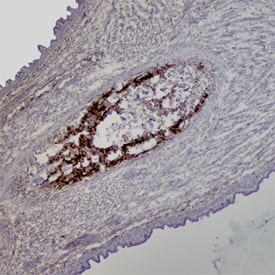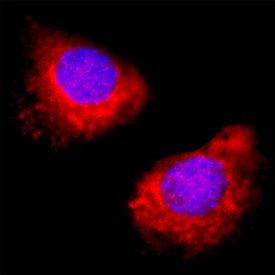Mouse SPARC Antibody
R&D Systems, part of Bio-Techne | Catalog # AF942


Key Product Details
Species Reactivity
Validated:
Cited:
Applications
Validated:
Cited:
Label
Antibody Source
Product Specifications
Immunogen
Ala18-Ile302
Accession # P07214
Specificity
Clonality
Host
Isotype
Scientific Data Images for Mouse SPARC Antibody
Detection of Mouse SPARC by Western Blot.
Western blot shows lysates of C2C12 mouse myoblast cell line and mouse placenta tissue. PVDF membrane was probed with 0.2 µg/mL of Goat Anti-Mouse SPARC Antigen Affinity-purified Polyclonal Antibody (Catalog # AF942) followed by HRP-conjugated Anti-Goat IgG Secondary Antibody (Catalog # HAF017). A specific band was detected for SPARC at approximately 35-37 kDa (as indicated). This experiment was conducted under reducing conditions and using Immunoblot Buffer Group 1.SPARC/Osteonectin in Mouse Embryo.
SPARC/Osteonectin was detected in immersion fixed frozen sections of mouse embryo (E15) using Mouse SPARC/ Osteonectin Antigen Affinity-purified Polyclonal Antibody (Catalog # AF942) at 1.7 µg/mL overnight at 4 °C. Tissue was stained using the Anti-Goat HRP-DAB Cell & Tissue Staining Kit (brown; Catalog # CTS008) and counterstained with hematoxylin (blue). Specific staining was localized to developing cartilage. View our protocol for Chromogenic IHC Staining of Frozen Tissue Sections.SPARC in C2C12 Mouse Cell Line.
SPARC was detected in immersion fixed C2C12 mouse myoblast cell line using Goat Anti-Mouse SPARC Antigen Affinity-purified Polyclonal Antibody (Catalog # AF942) at 5 µg/mL for 3 hours at room temperature. Cells were stained using the NorthernLights™ 557-conjugated Anti-Goat IgG Secondary Antibody (red; Catalog # NL001) and counterstained with DAPI (blue). Specific staining was localized to endoplasmic reticuli. View our protocol for Fluorescent ICC Staining of Cells on Coverslips.Applications for Mouse SPARC Antibody
CyTOF-ready
Immunocytochemistry
Sample: Immersion fixed C2C12 mouse myoblast cell line
Immunohistochemistry
Sample: Immersion fixed frozen sections of mouse embryo (E15)
Intracellular Staining by Flow Cytometry
Sample: Balb/C-3T3 mouse embryonic fibroblast cell line fixed with paraformaldehyde and permeabilized with saponin
Western Blot
Sample: C2C12 mouse myoblast cell line and mouse placenta tissue
Reviewed Applications
Read 3 reviews rated 4.7 using AF942 in the following applications:
Formulation, Preparation, and Storage
Purification
Reconstitution
Formulation
Shipping
Stability & Storage
- 12 months from date of receipt, -20 to -70 °C as supplied.
- 1 month, 2 to 8 °C under sterile conditions after reconstitution.
- 6 months, -20 to -70 °C under sterile conditions after reconstitution.
Background: SPARC
SPARC, an acronym for “secreted protein, acidic and rich in cysteine”, is also known as osteonectin or BM-40 (1-5). It is the founding member of a family of secreted matricellular proteins with similar domain structure. The 302 amino acid (aa), 43 kDa protein contains a 17 aa signal sequence, an N-terminal acidic region that binds calcium, a follistatin domain containing Kazal-like sequences, and a C-terminal extracellular calcium (EC) binding domain with two EF-hand motifs (1-5). Crystal structure shows that residues implicated in cell binding, inhibition of cell spreading and disassembly of focal adhesions cluster on one face of SPARC, while a collagen binding epitope and an N-glycosylation site are opposite this face (6). SPARC is produced by fibroblasts, capillary endothelial cells, platelets, and macrophages, especially in areas of tissue morphogenesis and remodeling (3, 7). SPARC shows context-specific effects, but generally inhibits adhesion, spreading and proliferation, and promotes collagen matrix formation (3-5). For endothelial cells, SPARC disrupts focal adhesions and binds and sequesters PDGF and VEGF (3-5). SPARC is abundantly expressed in bone, where it promotes osteoblast differentiation and inhibits adipogenesis (5, 8). SPARC is potentially cleaved by metalloproteinases, producing an angiogenic peptide that includes the copper-binding sequence KGHK (7). Paradoxically, SPARC is highly expressed in many tumor types, yet expression mainly decreases the likelihood of metastasis and confers sensitivity to chemotherapy and radiation (4, 9, 10). Stabilin-1, which is expressed on alternately activated macrophages, is the first SPARC receptor to be identified. It binds the SPARC EC domain and mediates endocytosis for degradation (11). Mature mouse SPARC shows 97%, 92%, 92%, 92%, and 83% aa identity with rat, human, dog, cow, and chick SPARC, respectively.
References
- Lankat-Buttgereit, B. et al. (1988) FEBS Lett. 236:352.
- McVey, J.H. et al. (1988) J. Biol. Chem. 263:11111.
- Sage, H. et al. (1989) J. Cell Biol. 109:341.
- Framson, P.E. and E.H. Sage (2004) J. Cell. Biochem. 92:679.
- Alford, A.I. and K.D. Hankenson (2006) Bone 38:749.
- Hohenester, E. et al. (1997) EMBO J. 16:3778.
- Sage, E.H. et al. (2003) J. Biol. Chem. 278:37849.
- Delany, A.M. et al. (2003) Endocrinology 144:2588.
- Koblinski, J.E. et al. (2005) Cancer Res. 65:7370.
- Tai, I.T. et al. (2005) J. Clin. Invest. 115:1492.
- Kzhyshkowska, J. et al. (2006) J. Immunol. 176:5825.
Long Name
Alternate Names
Gene Symbol
UniProt
Additional SPARC Products
Product Documents for Mouse SPARC Antibody
Product Specific Notices for Mouse SPARC Antibody
For research use only


